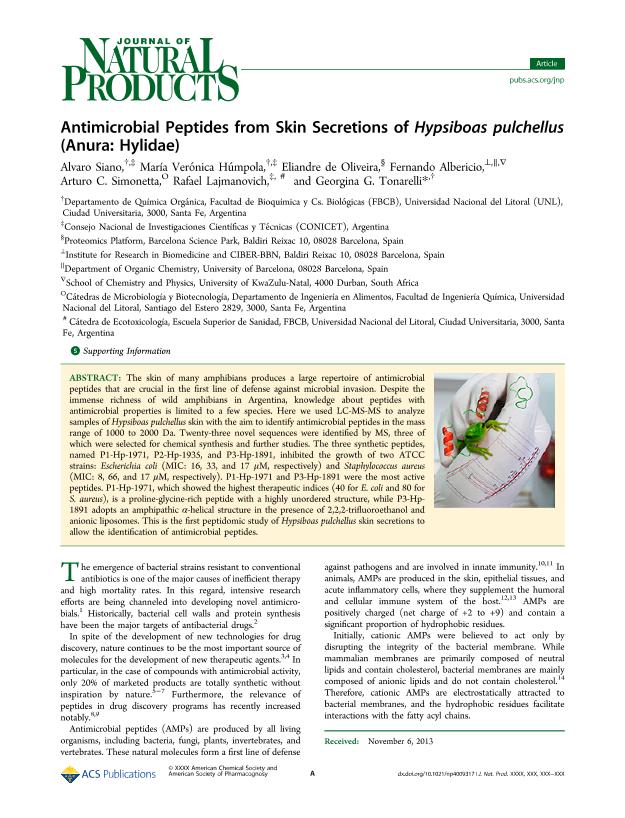Artículo
Antimicrobial Peptides from Skin Secretions of Hypsiboas pulchellus (Anura: Hylidae)
Siano, Alvaro Sebastían ; Húmpola, Maria Veronica
; Húmpola, Maria Veronica ; Olivera, Eliandre de; Fernando, Albericio; Simonetta, Arturo Carlos; Lajmanovich, Rafael Carlos
; Olivera, Eliandre de; Fernando, Albericio; Simonetta, Arturo Carlos; Lajmanovich, Rafael Carlos ; Tonarelli, Georgina Guadalupe
; Tonarelli, Georgina Guadalupe
 ; Húmpola, Maria Veronica
; Húmpola, Maria Veronica ; Olivera, Eliandre de; Fernando, Albericio; Simonetta, Arturo Carlos; Lajmanovich, Rafael Carlos
; Olivera, Eliandre de; Fernando, Albericio; Simonetta, Arturo Carlos; Lajmanovich, Rafael Carlos ; Tonarelli, Georgina Guadalupe
; Tonarelli, Georgina Guadalupe
Fecha de publicación:
04/2014
Editorial:
American Chemical Society
Revista:
Journal of Natural Products
ISSN:
0163-3864
Idioma:
Inglés
Tipo de recurso:
Artículo publicado
Clasificación temática:
Resumen
The skin of many amphibians produces a large repertoire of antimicrobial peptides that are crucial in the first line of defense against microbial invasion. Despite the immense richness of wild amphibians in Argentina, knowledge about peptides with antimicrobial properties is limited to a few species. Here we used LC-MS-MS to analyze samples of Hypsiboas pulchellus skin with the aim to identify antimicrobial peptides in the mass range of 1000 to 2000 Da. Twenty-three novel sequences were identified by MS, three of which were selected for chemical synthesis and further studies. The three synthetic peptides, named P1-Hp-1971, P2-Hp-1935, and P3-Hp-1891, inhibited the growth of two ATCC strains: Escherichia coli (MIC: 16, 33, and 17 μM, respectively) and Staphylococcus aureus (MIC: 8, 66, and 17 μM, respectively). P1-Hp-1971 and P3-Hp-1891 were the most active peptides. P1-Hp-1971, which showed the highest therapeutic indices (40 for E. coli and 80 for S. aureus), is a proline-glycine-rich peptide with a highly unordered structure, while P3-Hp-1891 adopts an amphipathic α-helical structure in the presence of 2,2,2-trifluoroethanol and anionic liposomes. This is the first peptidomic study of Hypsiboas pulchellus skin secretions to allow the identification of antimicrobial peptides.
Palabras clave:
Peptidomics
,
Amphibian
,
Mass Spectrometry
,
Antimicrobial Peptides
Archivos asociados
Licencia
Identificadores
Colecciones
Articulos(CCT - SANTA FE)
Articulos de CTRO.CIENTIFICO TECNOL.CONICET - SANTA FE
Articulos de CTRO.CIENTIFICO TECNOL.CONICET - SANTA FE
Citación
Tonarelli, Georgina Guadalupe; Lajmanovich, Rafael Carlos; Simonetta, Arturo Carlos; Fernando, Albericio; Olivera, Eliandre de; Húmpola, Maria Veronica; et al.; Antimicrobial Peptides from Skin Secretions of Hypsiboas pulchellus (Anura: Hylidae); American Chemical Society; Journal of Natural Products; 77; 4; 4-2014; 831-841
Compartir
Altmétricas



